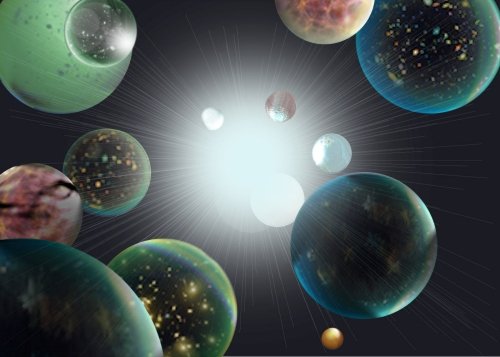 |
| Artist's Concept of a Multiverse |
Is our universe just one of the many existing universe?
While the concepts are bizarre, it’s real possibility according to the minds of the scientists who have organized the first test to investigate the idea.
The probability that we live in a multiverse arises from a theory known as the eternal inflation which says that shortly after the Big Bang that made the universe, space time extended at different regions, which give rise to bubble universes that may have their own laws of physics.
In a new observation researchers suggest that if our universe its siblings, we may have bumped into them. Such type of collisions would have left its last signs in the CMB (Cosmic Microwave Background) radiation, the diffused light left over from the big bang that pervades the universe, the explorers say.
“It brings about the idea of eternal inflation and bubble collisions into the realm of testable science.” said Daniel Mortlock, research team member and an astrophysicist at the Imperial College at London. "If it's not testable, it's hard to even call it science."
Daniel and the team lead by Stephen Finney, graduate student of University College London, studied the best available information of the CMB for signs of Bubble universe collisions, but he didn’t find anything that concluded the research. If there would have been any collision it would have left a circular pattern behind in the CMB.
"If you imagine two ordinary soap bubbles colliding, then the surface where they intersect is going to be a circle, so that's the key signature we're looking for in the CMB," Mortlock told SPACE.com.”It’s not any old perturbation, it’s circular and it has got particular type if profile. There’s no other thing that could cause this.
The researchers made a computer algorithm to analyze CMB observations for patterns that would set right. In data from NASA’s WMAP (Wilkinson Microwave Anisotropy Probe), the program found four places in the universe that were flagged as promising. Meanwhile the stats suggested these patterns were likely to be random, resembling the circular shapes of collisions simply by coincidence.
Data received from the European Space Agency’s Planck satellite, which was launched in 2009 are expected to be far more detailed than NASA’s WMAP. The Planck satellite results are decided to be released in 2013, and the researchers plan to look again, surveying in particular four places of interest in this project.
The universe that's 'just right'
The ideas of other universes being studied is mind bending, but scientists reveal that it makes sense in other ways.
Many of the fundamental constants in the universe, such as the strength and power of gravity, seem perfect to produce a universe in which planets, suns, stars and even life is possible. If any type of experiment is done with these constants, all universes would likely to be empty, with no moon and no light.
But if our universe is one of many, then the fact that it's so perfectly tuned for life isn't such an unlikely coincidence.
No comments:
Post a Comment